Introduction
The long-established sales strategies and practices used successfully to drive B2C and B2B activities over the years are experiencing a substantial change to meet the modern-day disruptive challenges encountered with the emergence of empowered customers. The well-recognized traditional sales model is fashioned primarily on a passive customer persona and structured with go-to-market strategies and plans with little or no direct customer sway. As buyer behaviors evolve with the dissimilarities and purchasing habits of the five generations (Silent to Gen Z) currently making and influencing purchase decisions, sales executives need to keep pace with rising customer needs and expectations. Future sales success in a digital-focused marketplace will require a rethinking of customer touchpoints and service preferences. Emerging technology advances will become the most critical catalyst for change within corporate sales!
“Today’s customers no longer care where or from whom they buy—they are a new generation of aggressive, internet-empowered customers—they are the “new experts.”
American Management Association (AMA)
The most successful salespeople built a rewarding long-term customer relationship, over the years, on an in-depth product, market, and competitor knowledge. It was not unusual that the salesperson in past times leveraged and, in many ways, exploited their customer’s lack of product knowledge to drive wins. This relationship was straightforward to sell with a FUD (Fear-Uncertainty-Doubt) approach that weaponizes the competition and offerings. By spreading disinformation about rival products’ shortcomings, a business could dissuade decision-makers from choosing those products over its own, providing a negative narrative. Nowadays, the digital era has allowed buyers, in many cases, to become as or more conversant and savvier on product background information as salespersons, and the use of FUD today can be viewed as a historical business artifact.
“The beauty of the disruption economy is that it enables two opportunities. First, it allows companies to redefine how and why they work. Such an organizational awakening then leads into the second opportunity for companies to adopt: a better way to serve employees who choose to work there because they believe in the company’s purpose.”
Forbes
Successful businesses in most market segments realize that change initiatives typically result in significant disruption to the production and customer journey handled by way of internal and external processes and activities, affecting employees, customers, and partners. However, most also grasp the need and value of the long-term benefits realized from evolution to a customer-centric business populated with empowered customers. In this context, the leadership team needs to: persistently and proactively identify, quantify, prioritize, and implement customer-driven strategies and diligently monitor the financial and non-financial results with a critical success factors (CSFs) spotlight.
The below graphic displays the critical areas of business focus concerned with effectively selling products and services within the strategic thinking and alignment espoused by sales professionals in a customer-centric environment.

“B2B sales organizations need to shift their go-to-market strategies to continuous, parallel engagements where sales, marketing, customer service, and customer success teams align to help buyers complete critical buying tasks. This could mean removing the distinctions among sales, marketing and customer service entirely and consolidating all commercial resources into a single commercial operations team.”
Gartner
Sales Roles, Approaches, & Techniques
For many businesses in 2020 and now in 2021, disruption has become an enduring precondition of conducting business requiring constant attention and strategic intrusion. Best practices dictate that companies should anticipate continuous change with timely redesigns of sales strategies, organizational structures and roles, and go-to-market plans to keep pace with current market developments. Redesign efforts require the building of robust and flexible structures and processes to enable successful future changes while maintaining enterprise strategic alignment. The value of these actions includes creating the appropriate strategic policies and programs for taking quick advantage of favorable market opportunities and mitigating exposures to financial and operating risks.
Customer expectations for quality, performance, and pricing intensify in the current economy, driven by innovative technologies from artificial intelligence, chatbots, and virtual reality tools to enhance the shopping and product user experience. Combined with increased competition from within and outside of product market segments, business leaders need to be offensive in acquiring new name customers and defending customer loss by switching to competitors and instances of deadly churn.
To produce sustained and profitable growth, companies must have a clearly-defined sales and support strategy and approach to acquire customers and retain them. The critical element of a redirected corporate sales activity is a strategy with a customer-centric focus.
Today, empowered customers are highly knowledgeable about their needs and marketplace offerings. With the myriad of similar products available, buyers can effortlessly acquire products and services from competitors with unsatisfied needs and expectations. The always present threat of post-sale customer loss means smart businesses must provide the appropriate product and service with the promoted value via the customer preference sales, delivery, and service touchpoints, within agreed SLAs (Service Level Agreements) a competitive price.
Forbes reports:
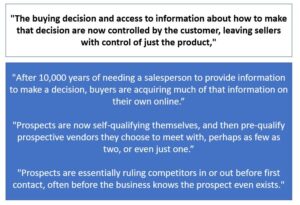
Sales Roles
The sales activity will continue to be the pivotal point of contact between a business and its customers in the modern market. By tradition, the sales role ensures that customers purchase the right products and services, continually demonstrate value to support continued loyalty and repeat business, and pursue new cross-sell and upsell opportunities. For the most part, these responsibilities face transformation from now on based on the current and emerging business and technology environment, lifestyle considerations, and governmental regulations and decisions. The targeted use of technology to handle mundane but necessary chores, collapsing of unproductive marketing and other functional silos, and the integration and streamlining of customer-centric processes will effectively supercharge the sales mission and charter. In many ways, technology will be the prime catalyst to improve overall sales productivity by increasing the salespersons’ available time allocated to drive the customer journey.
Marketing and sales activities have been historically set-up with fuzzy and inconsistent charters, resulting in ineffective and time-delayed decision-making on delivering seamless customer-centric experiences, differentiated with competitors, and highly personalized. Future business success will require smart and timely changes predicated with policies and practices that anticipate market disruption and quickly reshape the sales organization to meet the challenges presented for survival and sustainability.
The current and future sales organization consists of four generic components, open for continually changing, as shown below.
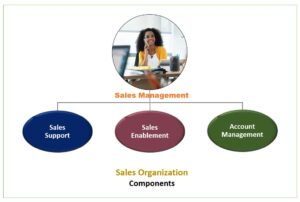
The strategic redesign of traditional sales roles and responsibilities requires analysis and practical adaptations to meet a disruptive marketplace’s challenges. The table below provides descriptions of the hands-on sales positions that should prove helpful in rethinking and possibly restructuring the sales organization.
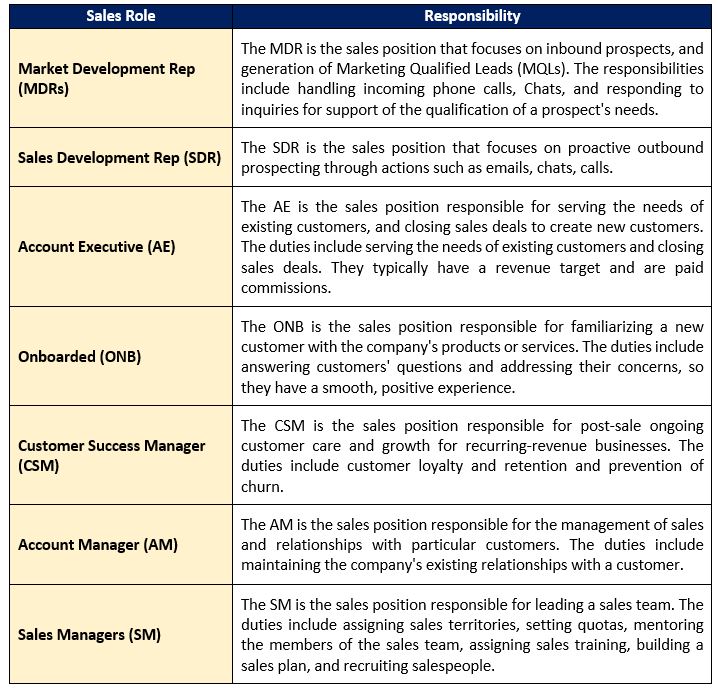
There are many successful sales structures, but there is no one size fits all approach, regrettably! The only constant postulate is a judicious fusing of the business model with customer goals and expectations. This application avoids unintentional damage to customer relations with revenue consequences by rogue sales professionals.
The use of a Customer Success Manager (CSM) positioned as a post-sales bridge between sales and customer support is emerging as an attractive tactic for proactively helping customers implement and use the product or service successfully. The CSM, in particular companies, is replacing the Account Executive (AE) and the Account Manager (AM). In some situations, the CSM and AE or AM roles combine into a highly-productive customer-centric position with hybrid responsibilities.
“Statistics suggest that when customers complain, business owners and managers ought to get excited about it. The complaining customer represents a huge opportunity of more business.”
Zig Ziglar
Sales Approaches
All customers are not the same as some generate more revenue, have different business requirements and service needs, and fewer costs than others. Businesses today must identify precisely how to focus their valuable customer-centric resources with the appropriate sales approach to maintain high corporate productivity and meet financial projections.
A sales approach is a standardized roadmap with repeatable steps that sales use to guide a prospective buyer from an early stage of awareness to a closed deal. An alternative definition is a potential customer’s journey from recognizing a need to purchasing a particular product or service.
Some sales approaches have remained viable tools over the years because of recognized success in assisting salespersons in building business relationships and winning sales.
Others that have fallen out of favor and use might still prove useful with particular sales situations as a standalone or blended with others. For example, the notion of driving prospects through a sales funnel is not relevant nowadays. The empowered and informed consumer needs a dedicated salesperson to meet them on their journey and assist them with their purchase decisions.
A company’s sales approach needs to be genuinely helpful with prospects by researching, misunderstanding their pain points and challenges, supporting educational experiences, and crafting personalized and customized solutions rather than merely selling via a generic pitch.
Presented below is a generic sales process representing a starting point for the formalization of a sales approach.
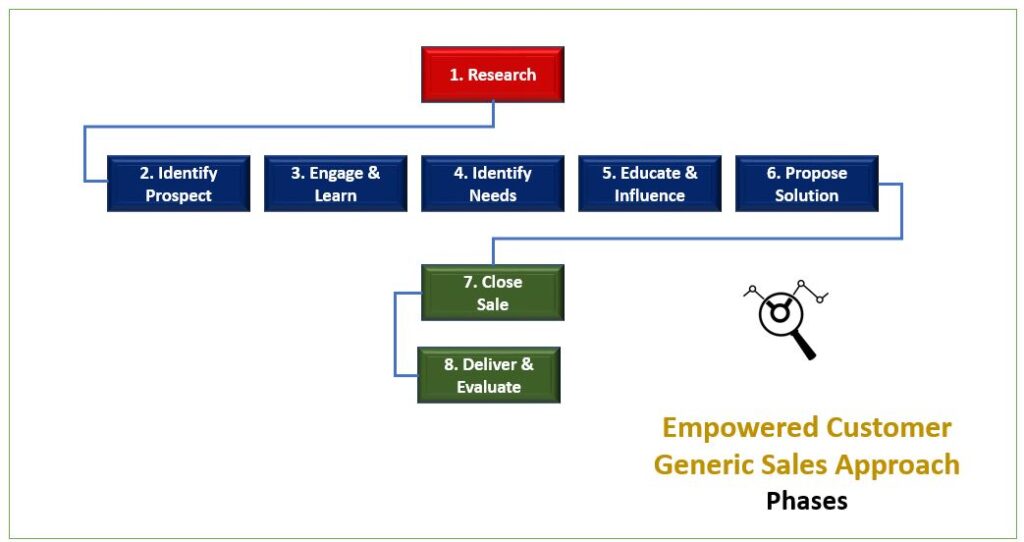
The generic sales approach value increases significantly with the use and customization of one or more of the strategic choices displayed below that support a company’s corporate sales strategies and plans.

“If you make customers unhappy in the physical world, they might each tell six friends. If you make customers unhappy on the internet, they can each tell 6,000.”
Jeff Bezos
The Consultative approach is closely related to the theory and basic principles of SPIN selling, as detailed in SPIN Selling, a book authored by Neil Rackham and published in 1988. SPIN Selling (Situation, Problem, Implication, Need) describes a dynamic, collaborative sales approach that empowers individual salespeople and teams to instantly become more customer-centric by revealing the questions that build rapport, credibility and drive successful sales. The New York Times reports that Spin Selling is one of their all-time business bestsellers.
“The key is to set realistic customer expectations, and then not to just meet them, but to exceed them—preferably in unexpected and helpful ways.”
Richard Branson
Sales Techniques
 During the 1900s, the day’s top companies generally relied on territory-based commissioned traveling salespeople using a ‘door-to-door’ or similar sales approach to prospect and sell, with cold calling a broadly accepted best practice. Also, dining and entertainment prospects was a widely-used practice, and some sales individuals employed the nefarious ‘snake-oil’ sales proposition.
During the 1900s, the day’s top companies generally relied on territory-based commissioned traveling salespeople using a ‘door-to-door’ or similar sales approach to prospect and sell, with cold calling a broadly accepted best practice. Also, dining and entertainment prospects was a widely-used practice, and some sales individuals employed the nefarious ‘snake-oil’ sales proposition.
The coming of the twenty-first-century traditional sales practices became challenged as out-of-date and in need of modernization. The maxim of sales being more of an art than science has never been further from the truth with the innovative technology dynamic. It was also clear that the days of excessive schmoozing with prospects and customers over social and sport and other events were being limited or prohibited! This century introduced many innovative changes to the business community, rising from complicated and costly new products, changing generational purchasing behaviors, social media attractiveness, and technology transformation. These developments pushed business leaders to reexamine their sales practices for their suitability within a digital-driven environment.
Successful salespeople are well-recognized for creating innovative and highly-productive techniques to support their company business strategy and selective sales approach. Priority attention centers on social media, domain focus, technical experience sharing, knowledge creation, and value-add content publication in the current business climate.
Outlined below summarizes modern-day sales techniques that directly influence targeted prospects and collapse the sales cycle.
Social Selling
An array of recent market research reports that about 93% of decision-makers never respond to cold calls, including e-mail sales campaigns. These days, the selling rules have changed radically with the allure of using social media to quickly and cost-effectively engage with target prospects. There is a wide array of social selling activities in many variations conducted on social media platforms with customized search and collaboration characteristics.
Social selling leverages salespeople’s social network participation to identify, connect, qualify, and cultivate prospects within online ecosystems. It’s the contemporary approach to develop trust-based associations with fellow industry professionals targeted as potential customers. These sales techniques can quickly open enduring online dialogs resulting in sales and eliminating cold calling.
LinkedIn describes Social Selling as a structure with Four Pillars shown in the below graphic.
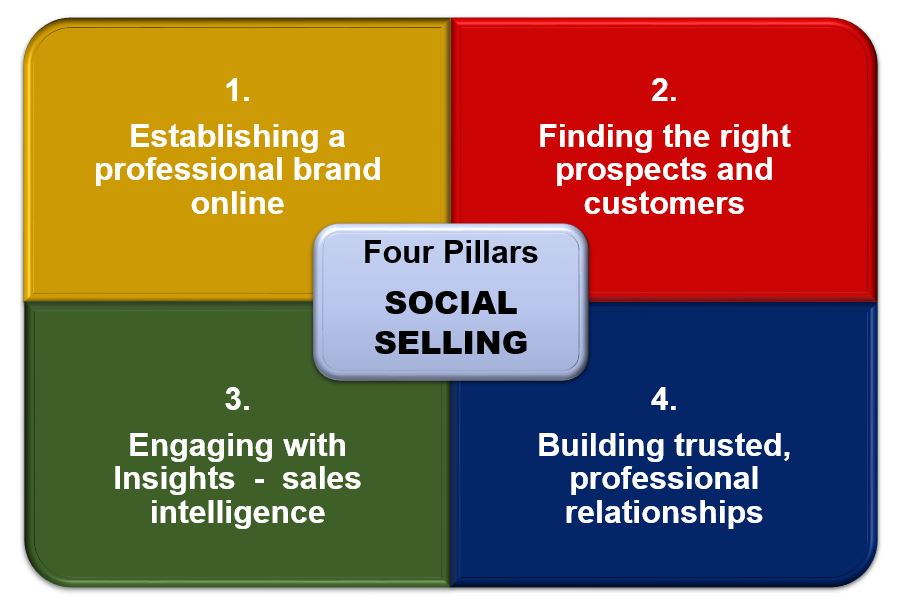
There have been many cutting-edge social selling practices facilitated on the leading social networks, including LinkedIn, Twitter, Facebook, and Pinterest, in recent years. It appears that many companies are developing personalized social selling strategies with regular use of select primary platforms based on their particular product and service considerations and requirements.
Social selling is not about overwhelming an extensive list of anonymous contacts with unsolicited spam type communications! A blunder made by many salespeople is to reach out with an unsolicited sales e-mail campaign immediately upon identification of potential prospects. In many ways, this approach is akin to cold selling that has a historically flat success rate. Effective social selling aims to build real and sustainable business relationships based on similar roles, competencies, and interests and continually listen and recognize opportunities to collaborate, share experiences, and present products and services.
The best course of action is to engage targeted social media participants routinely with stimulating and value-add conversation to discover and establish insights on their personal and employer profiles and needs. This action will usually result in an understanding and deep appreciation of the prospects’ pain points and requirements and support future purchase situations. Also, salespeople demonstrating a deep and reflective interest in the prospect’s business will undoubtedly build the burgeoning prospect relationship to a trust-worthy status more quickly.
A critical requirement for high-performance social selling within an organizational context is the dedication of consistent daily resources to listen and quickly respond to priority sales interest postings. A quick riposte to posts is not an option as the overwhelming social media volume means that potential opportunities may have a useful life measured in minutes. Social media responses need to be smart and highly professional in appearance and tone, appropriate and valuable to the problem or opportunity identified and crafted without grammar, spelling, and punctuation miscues. Experience shows that it takes only one unimpressive response to damage a business relationship beyond repair in the social media setting.
A successful social selling program can realize benefits that exceed traditional sales activities, as outlined below.
Increase quality leads.
Improve lead conversion rate.
Establish genuine business relationships versus closing transactions.
Reduce presales cycle time.
Improve market brand and reputation.
Expand customer retention/repeat customers.
Increase sales productivity.
“People influence people. Nothing influences people more than a recommendation from a trusted friend. A trusted referral influences people more than the best broadcast message.”
Mark Zuckerberg
Expertise Sharing
It is not unusual that businesspeople, in all industries and roles, have times where they are at a loss for relevant knowledge to help in problem- solving or leveraging, or exploiting an opportunity. These circumstances represent an exploitable opportunity for sales associates in the sales arena that encounter prospects delaying purchase decisions lacking experience or supporting information references.
Expertise sharing, in a sales context, is a collaboration activity through which knowledge and skills are furnished to prospects to assist in knowledge-building and decision-making. Devoid of actual and relative experience and knowledge, even the best people can make the wrong decision or no-decision.
Upon facing prospect knowledge-shortfall situations, the salesperson should enthusiastically and without restrictions offer and share the required information and insights and conduct experience sessions necessary to help drive quick decision-making. Prospects generally view this invaluable support as a positive relationship and trust-building event to acquire highly-useful knowledge they could not obtain from internal or other sources.
Salespeople can use knowledge-sharing as a proactive sales technique with prospects before or during presales situations. Most savvy business managers, without hesitation, will appreciate the assistance as a valuable gift that merits reciprocity.
Many companies are risk-averse to sharing corporate knowledge and insights as they believe that the content is intellectual property (IP) that prospects may wrongly pass to competitors. This premise is not viable in the modern workplace as the shareable content can be restricted for use and distribution and legally covered under a non-disclosure agreement.
The key benefits of knowledge sharing with prospects encompass:
- Supplement the prospect’s team knowledge required to make the appropriate purchase decisions.
- Improve the standing of the seller as a valuable business resource.
- Reduce the presales’ life cycle time and effort requirements.
- Improve the opportunity to cross-sell and upsell products and services.
Knowledge Creation & Credentials
Gravitas is an essential criterion used to evaluate products and services businesses and easily recognized in the company’s business credentials. Credentials help companies validate and promote their knowledge and skills in both the market and technical domains and support their brands’ value.
An essential component of a business’s credentials is the articles, journals, and other content-supported documents authored by company employees. These publications support the professional level of thinking and the generation of innovative new models and designs, and theories that advance science, technology, and business management.
Companies with recognized domain and technology professionals and specialists generally have more knowledge in tacit than explicit form. It behooves these organizations to provide incentives for their top talent to author and publish articles and other publications within their business, technology, and science community and trade and industry associations.
As a hands-on technique, the sales team should reference and highlight company-authored publications on their website and blog and postings on the top social media sites, with prospects that have comparable problematic and opportunistic business conditions. It would also benefit sales associates to introduce select content authors into the presales cycle for collaborative discussions with the prospects.
“A brand is no longer what we tell the consumer it is – it is what consumers tell each other it is.”
Scott Cook
Salespersons Personality Traits
Personality traits shaped by inheritance and environmental factors and tend to stay stable over time define how we interrelate with family, friends, work colleagues, and strangers. It takes a specific personality type to be a winner and thrive in a fast-paced, dynamic sales environment. Salespeople traits are crucial drivers in determining their ultimate success. The good news is that personality traits change for the better based on new life experiences and training!
The traits required to be successful salespeople have continually changed over the years to meet current-day purchasers’ needs and expectations. Today, the coming together of the customer’s age and participation of five generations as active purchasers require a more accommodating and empathetic salesperson than in past eras.
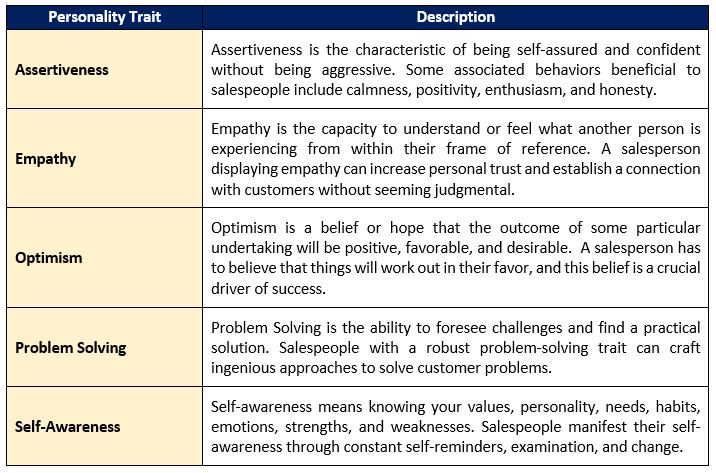
Customer Touchpoints and Services Preferences
Customer touchpoints are the prime windows of communication with buyers. They represent unique opportunities to demonstrate the corporate brand’s value by exceeding expectations in resolving product and service disputes quickly, defusing distraught and troubled customer complaints positively, and authorizing ‘on the spot’ claims, discounts, and other financial resolutions. However, a disappointing touchpoint experience can damage a relationship and potentially result in customer loss and revenue. Nowadays, available touchpoints cover a wide array of in-person physical and digital settings. As a common prerequisite, most buyers value business providers that are structured holistically with integrated touchpoints characterized as professional, competent, and consistent.
It is essential to identify and prioritize the targeted customer category touchpoints preferences considered prerequisites to establishing and maintaining a profitable business relationship within a corporate sales strategy. For example, most Millennial and Gen Z individuals are attracted to digital and online tools use. Simultaneously, Gen X, Baby Boomers, and the Silent Generation tend to be traditional in their communications choices. The key goal is to offer the appropriate connected and contextualized touchpoints to the targeted customer types that reflect an understanding of the customer preferences, business history, and product service usage.
“If you think you’ll have plenty of time to get it right because you’re a beloved brand, think again. Imagine losing one-quarter of your customers in a single day. For good. Because that’s exactly what could happen after just one bad customer experience. In the U.S., even when people love a company or product, 59% will walk away after several bad experiences, 17% after just one bad experience.”
PwC
A useful set of techniques to determine the appropriate touchpoints is customer interaction mapping and assessment and industry best practices GAP analysis. These techniques diagrams the current (as-is) and potential redesign (to-be) steps of the buyer’s journey, supporting before and after purchase practices with all elements of the company’s digital and physical infrastructures. The mapping organizes the results sequentially to detail customer’s contact experiences with an overlaid of customer preferences and identification of GAPs with industry norms. The deliverable is a baseline of best-practice production touchpoints comprising current and newly required touchpoints (to be built) and actions to repair or enhance customer-challenging presales and post-sale support practices.
Shown below is a graphic that presents the most widely used touchpoints in the business community.
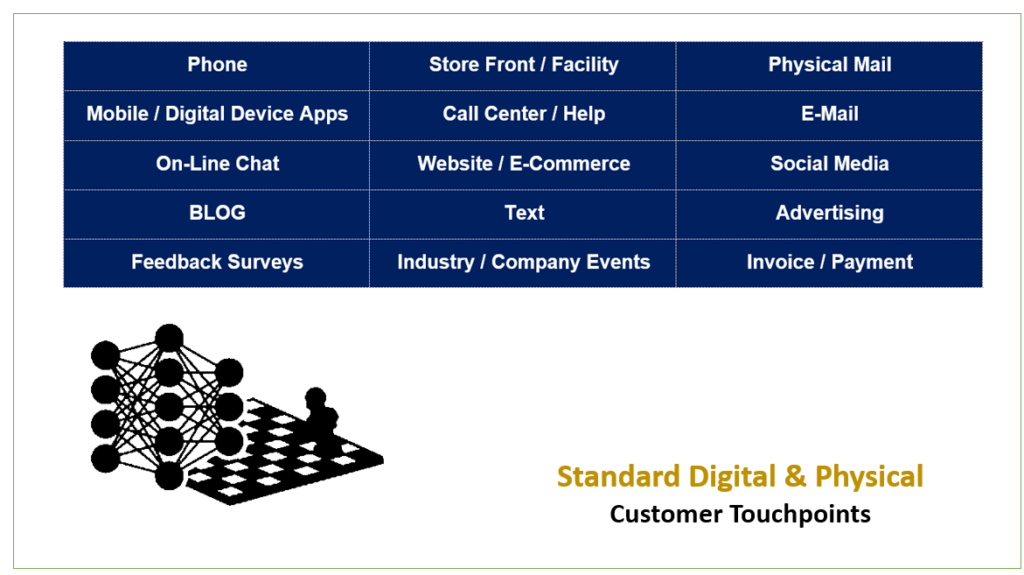
“Every sale has five basic obstacles: no need, no money, no hurry, no desire, no trust.”
Zig Ziglar
Generational Customer Personalized Needs
Multi-generational marketing targets the needs and values of individuals within various generational groups. From the Silent Generation to Generation Z, each generation has its own defining culture that has characterized their coming-of-age and shopping habits. For example, each generation has atypical beliefs, values, generational chronicle, lifestyles, values, demographics, and social experiences that influence their purchasing behaviors and preferences. In this context, businesses need to proactively discover and comprehend these diverse consumer groups’ buying patterns and decision-making processes.
The two critical guidelines of multi-generational marketing and sales cover:
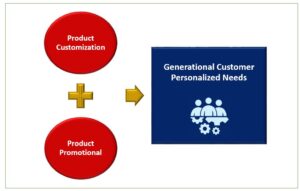
- Products require customization that supports generational life stage needs and their purchase decisions.
- Product promotional activities targeting generational groups reflect the values that drive buyer preferences and behavior.
In today’s competitive economy, successful businesses smartly respond to the changing trends and directions of generational requirements by validating buyer behavior and quickly adjusting their product composition and marketing and sales approaches and plans accordingly. Seasoned marketing executives typically blend the best traditional and modern-day marketing and sales practices instead of a total makeover. For example, many time-honored traditions may effectively support Baby Boomers and Gen X populations, while others may be digitally-enriched or discarded for the Millennials and Gen Z community.
It is vital to realize that generation is only one dynamic influencing purchasing behavior. For example, differences within a generation can be more significant than variations within particular groups. Also, generations typically do not have razor-sharp edges in that some people near a generational age break often do not belong clearly to either generation.
When a company factors in the generational elements, crafting more responsive marketing and sales strategies can more quickly win the targeted groups’ trust and confidence.
“I have never worked a day in my life without selling. If I believe in something, I sell it, and I sell it hard.”
Estée Lauder
The Way Forward
At Knowledge Compass, we bring together nearly four decades of thought leadership in business and technology strategy, the latest tools and best practices, and a seasoned consultant team with the competencies and talent to help our clients improve productivity and profitability.
Knowledge Compass explores and develops valuable new insights from business, technology, and science by embracing the powerful technology of ideas and brainstorming. Our consultants engage customers in challenging discussion and experimentation to expand business science boundaries and practice and translate creative ideas into practical solutions from within and beyond business.
Working with Knowledge Compass means a collaborative approach to understanding your current business model, strategies, and critical business requirements and goals.
We enable organizations to transform and deliver improved value by ensuring employees adapt and make the most effective use of crisis management and change practices in culture, strategy, infrastructure, processing, and digital transformation. Our consultants have a deep understanding of the social and business factors that support a people-based culture aligned with the appropriate corporate strategy and goals.
Knowledge Compass provides consulting services using time-tested best practice frameworks, analysis tools, and interactions from their professional Consultant Toolbox.


